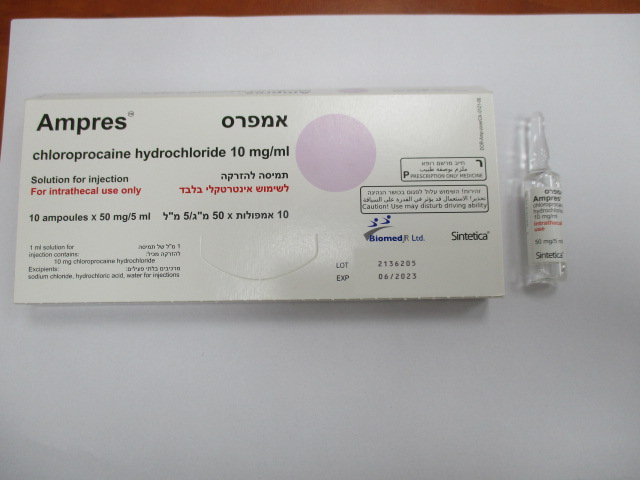Quest for the right Drug

אמפרס AMPRES (CHLOROPROCAINE HYDROCHLORIDE)
תרופה במרשם
תרופה בסל
נרקוטיקה
ציטוטוקסיקה
צורת מתן:
תוך-שדרתי : INTRATHECAL
צורת מינון:
תמיסה להזרקה : SOLUTION FOR INJECTION
עלון לרופא
מינוניםPosology התוויות
Indications תופעות לוואי
Adverse reactions התוויות נגד
Contraindications אינטראקציות
Interactions מינון יתר
Overdose הריון/הנקה
Pregnancy & Lactation אוכלוסיות מיוחדות
Special populations תכונות פרמקולוגיות
Pharmacological properties מידע רוקחי
Pharmaceutical particulars אזהרת שימוש
Special Warning עלון לרופא
Physicians Leaflet
Overdose : מינון יתר
4.9 Overdose It is unlikely that Ampres, at the recommended posology by intrathecal administration, will induce plasma levels capable of inducing systemic toxicity. Acute systemic toxicity Systemic undesirable effects are of methodological (due to use), pharmacodynamic or pharmacokinetic origin and concern the central nervous system and the cardiocirculatory system. Iatrogenic undesirable effects occur: − after injecting an excessive quantity of solution − from accidental injection into a vessel − from incorrect patient position − from high spinal anaesthesia (marked drop in arterial pressure) In the case of accidental intravenous administration, the toxic effect occurs within 1 minute. The intravenous LD50 of chloroprocaine HCl is 97 mg/kg in mice, 65 mg/kg in guinea pigs and <30 mg/kg in dogs, corresponding to human equivalent doses of 7.9 mg/kg, 14.1 mg/kg and < 16.7 mg/kg, respectively. The subcutaneous LD50 of chloroprocaine HCl in mice is 950 mg/kg, corresponding to human equivalent dose of 77.2 mg/kg, Signs of overdose can be classified into two different sets of symptoms which differ in terms of quality and intensity: Symptoms affecting the central nervous system Generally, the first symptoms are paresthesia in the mouth area, feeling of numbness of the tongue, feeling dazed, problems with hearing and tinnitus. Visual problems and muscle contractions are more severe and precede a generalized convulsion. These signs must not be erroneously mistaken for neurotic behaviour. Subsequently loss of consciousness and tonic-clonic seizure may occur, generally lasting between a few seconds and a few minutes. The convulsions are immediately followed by hypoxia and increased levels of carbon dioxide in the blood (hypercapnia), attributable to increased muscular activity associated with respiratory problems. In serious cases respiratory arrest may occur. Acidosis and/or hypoxia potentiate the toxic effects of local anaesthetics. The reduction or improvement of symptoms affecting the central nervous system can be attributed to the redistribution of local anaesthetic outside the CNS, with its consequent metabolism and excretion. Regression may be rapid, unless enormous quantities have been used. Cardiovascular symptoms In serious cases cardiovascular toxicity may occur. Hypotension, bradycardia, arrhythmia and also cardiac arrest may occur in the presence of a high systemic concentration of local anaesthetics. The first signs of toxic symptoms affecting the central nervous system generally precede toxic cardiovascular effects. This statement does not apply if the patient is under general anaesthesia or heavily sedated with medicinal products such as benzodiazepine or barbiturates. Treatment of acute systemic toxicity The following measures must be taken immediately: − Administration of Ampres must be stopped. − An adequate supply of oxygen must be ensured: the airways should be kept clear, O2 should be administered, artificial ventilation (intubation) if required. − In case of cardiovascular depression circulation must be stabilized. If convulsions occur and do not resolve spontaneously after 15-20 seconds, the administration of an intravenous anticonvulsant is recommended. Analeptics with a central action are contraindicated in the case of intoxication caused by local anaesthetics! In the event of serious complications, when treating the patient it is advisable to obtain the assistance of a doctor specializing in emergency medicine and resuscitation (e.g. anaesthetist). In patients with genetic deficiency of plasma cholinesterase an intravenous lipid solution could be administered.

שימוש לפי פנקס קופ''ח כללית 1994
לא צוין
תאריך הכללה מקורי בסל
לא צוין
הגבלות
לא צוין
מידע נוסף
